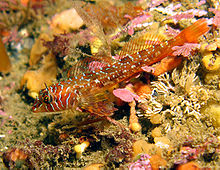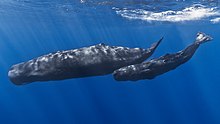Aquatic animal


An aquatic animal is any animal, whether vertebrate or invertebrate, that lives in bodies of water for all or most of its lifetime.[1] Aquatic animals generally conduct gas exchange in water by extracting dissolved oxygen via specialised respiratory organs called gills, through the skin or across enteral mucosae, although some are evolved from terrestrial ancestors that re-adapted to aquatic environments (e.g. marine reptiles and marine mammals), in which case they actually use lungs to breathe air and are essentially holding their breath when living in water. Some species of gastropod mollusc, such as the eastern emerald sea slug, are even capable of kleptoplastic photosynthesis via endosymbiosis with ingested yellow-green algae.
Almost all aquatic animals reproduce in water, either oviparously or viviparously, and many species routinely migrate between different water bodies during their life cycle. Some animals have fully aquatic life stages (typically as eggs and larvae), while as adults they become terrestrial or semi-aquatic after undergoing metamorphosis. Such examples include amphibians such as frogs, many flying insects such as mosquitoes, mayflies, dragonflies, damselflies and caddisflies, as well as some species of cephalopod molluscs such as the algae octopus (whose larvae are completely planktonic).
Aquatic animals are a diverse polyphyletic group based purely on the natural environments they inhabit, and any morphological and behavioral similarities among them are the result of convergent evolution. They are distinct from terrestrial and semi-aquatic animals, who can survive away from water bodies, while aquatic animals often die of dehydration or hypoxia after prolonged removal out of water due to either gill failure or compressive asphyxia by their own body weight (as in the case of whale beaching). Along with aquatic plants, algae and microbes, aquatic animals form the food webs of various marine, brackish and freshwater aquatic ecosystems.
Description
[edit]
The term aquatic can be applied to animals that live in either fresh water or salt water. However, the adjective marine is most commonly used for animals that live in saltwater, i.e. in oceans, seas, etc.
Aquatic animals (especially freshwater animals) are often of special concern to conservationists because of the fragility of their environments. Aquatic animals are subject to pressure from overfishing, destructive fishing, marine pollution, hunting, and climate change. Many habitats are at risk which puts aquatic animals at risk as well.[2] Aquatic animals play an important role in the world. The biodiversity of aquatic animals provide food, energy, and even jobs.[3]
Fresh water creates a hypotonic environment for aquatic organisms. This is problematic for some organisms with pervious skins or with gill membranes, whose cell membranes may burst if excess water is not excreted. Some protists accomplish this using contractile vacuoles, while freshwater fish excrete excess water via the kidney.[4] Although most aquatic organisms have a limited ability to regulate their osmotic balance and therefore can only live within a narrow range of salinity, diadromous fish have the ability to migrate between fresh water and saline water bodies. During these migrations they undergo changes to adapt to the surroundings of the changed salinities; these processes are hormonally controlled. The European eel (Anguilla anguilla) uses the hormone prolactin,[5] while in salmon (Salmo salar) the hormone cortisol plays a key role during this process.[6]
Freshwater molluscs include freshwater snails and freshwater bivalves. Freshwater crustaceans include freshwater crabs and crayfish.[7][8]
Air-breathing aquatic animal
[edit]In addition to water breathing animals, e.g., fish, most mollusks, etc., the term "aquatic animal" can be applied to air-breathing aquatic or sea mammals such as those in the orders Cetacea (whales) and Sirenia (sea cows), which cannot survive on land, as well as the pinnipeds (true seals, eared seals, and the walrus). The term "aquatic mammal" is also applied to four-footed mammals like the river otter (Lontra canadensis) and beavers (family Castoridae), although these are technically amphibious or semiaquatic. There are up to one million types of aquatic animals and aquatic species.[9]
Amphibians, like frogs (the order Anura), while requiring water, are separated into their own environmental classification. The majority of amphibians (class Amphibia) have an aquatic larval stage, like a tadpole, but then live as terrestrial adults, and may return to the water to mate.
Certain fish also evolved to breathe air to survive oxygen-deprived water, such as Arapaima (family Osteoglossidae) and walking catfish.
Most mollusks have gills, while some fresh water ones have a lung instead (e.g. Planorbidae) and some amphibious ones have both (e.g. This depends on the animals. Ampullariidae). Many species of aquatic animals lack a backbone or are invertebrates.[9]
Importance for environment
[edit]Aquatic animals play an important role for the environment as well as human's daily usage. The importance of aquatic animals comes from the fact that they are organisms that provide humans with sources such as food, medicine, energy shelter, and raw materials that are used for daily life.
Each aquatic species plays a different role to help us make every day easier, healthier, and also more productive. They also help with the atmospheric pressure and global climate change.[10]
See also
[edit]- Aquatic
- Aquatic ecosystem
- Aquatic locomotion
- Aquatic mammal
- Aquatic plant
- Freshwater snail
- Marine biology
- Marine invertebrates
- Marine mammal
- Terrestrial animal
- Terrestrial ecosystem
- Terrestrial locomotion
- Terrestrial plant
- Wetland – Land area that is permanently, or seasonally saturated with water
- Wetland indicator status
- Zoology
References
[edit]- ^ Biology Online Dictionary: "Aquatic" Archived 31 May 2009 at the Wayback Machine
- ^ "Protecting Marine Wildlife". The Humane Society of the United States. Retrieved 7 October 2020.
- ^ "World Organisation for Animal Health (OIE)". International Regulatory Co-operation. 2 November 2016. pp. 162–163. doi:10.1787/9789264244047-41-en. ISBN 9789264266254.
- ^ "Vertebrate Kidneys". 3 November 2002. Archived from the original on 29 April 2006. Retrieved 14 May 2006.
- ^ Kalujnaia, S.; et al. (2007). "Salinity adaptation and gene profiling analysis in the European eel (Anguilla anguilla) using microarray technology". Gen. Comp. Endocrinol. 152 (2007): 274–80. doi:10.1016/j.ygcen.2006.12.025. PMID 17324422.
- ^ Bisal, G.A.; Specker, J.L. (24 January 2006). "Cortisol stimulates hypo-osmoregulatory ability in Atlantic salmon, Salmo salar L". Journal of Fish Biology. 39 (3): 421–432. doi:10.1111/j.1095-8649.1991.tb04373.x.
- ^ "Nuôi trồng thủy sản, ngành học với nhiều cơ hội việc làm, đáp ứng nhu cầu xã hội". Archived from the original on 11 November 2016.
- ^ "Từ điển THUẬT NGỮ NUÔI TRỒNG THỦY SẢN của FAO năm 2008" (PDF). Archived from the original (PDF) on 8 January 2016.
- ^ a b "Ocean Habitat". National Geographic. 31 October 2016. Retrieved 28 October 2020.
- ^ What Is Aquatic Biodiversity; Why Is It Important?. Virginia, US. 2019. p. 2.
{{cite book}}: CS1 maint: location missing publisher (link)


